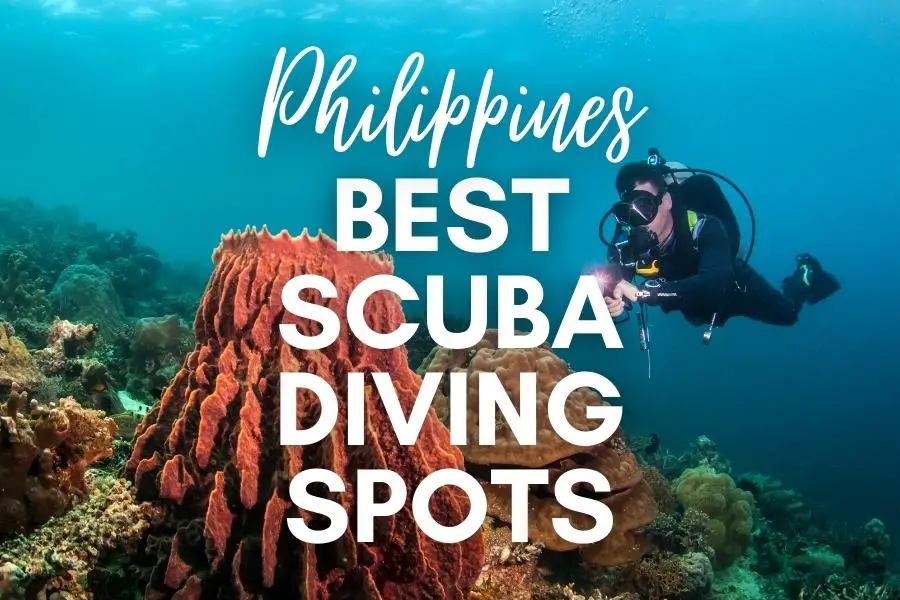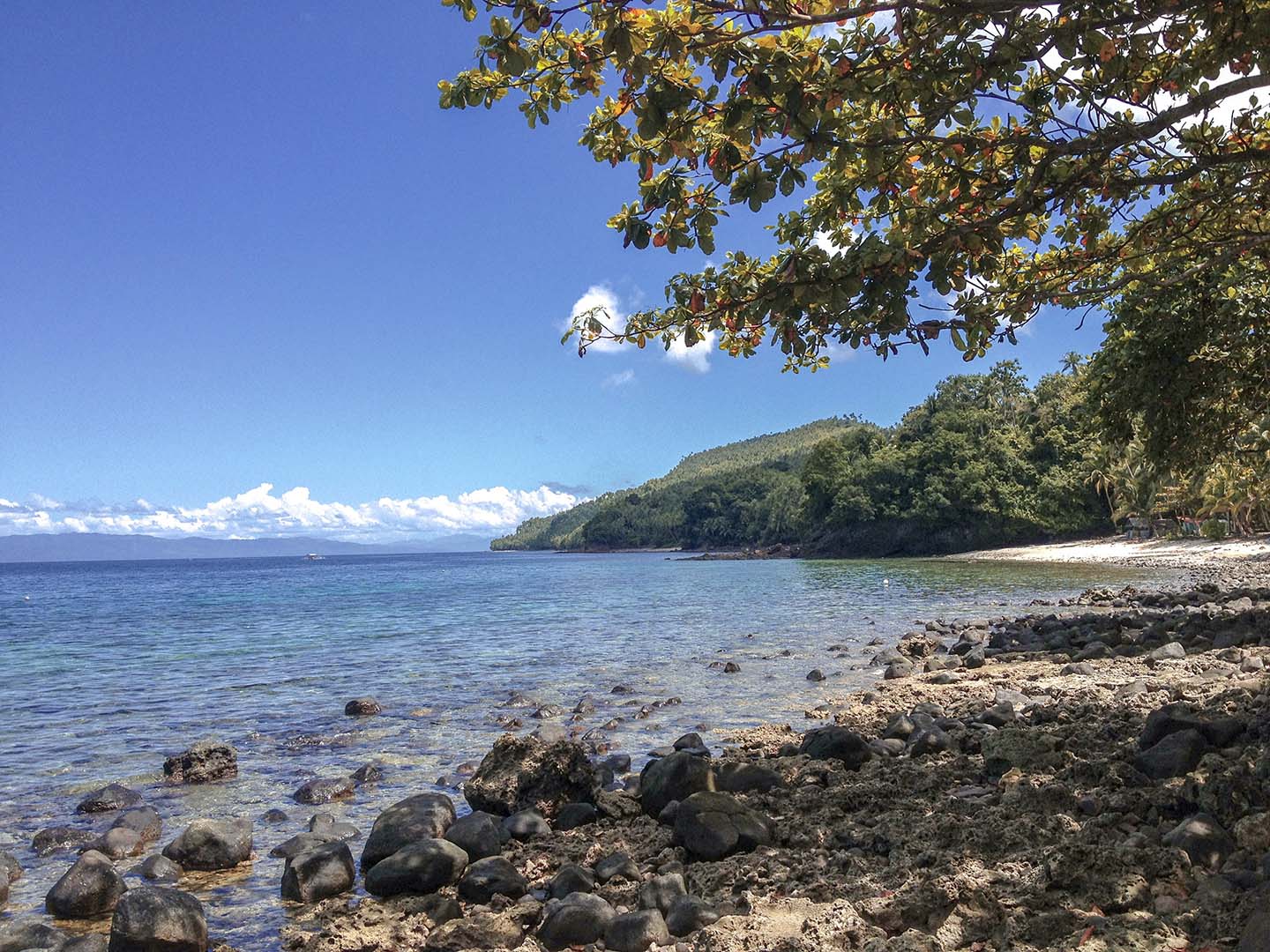The Philippines is a paradise for scuba divers. The country has a long coastline and more than 7,641 islands, so there are a lot of different marine environments to explore. From vibrant coral reefs to deep drop-offs and shipwrecks, it is truly a scuba diver’s dream destination.
Because of its location in the center of the Coral Triangle, the Philippines offer scuba divers an experience that cannot be replicated anywhere else in the world. The Philippines sits at the very heart of the Coral Triangle, which is widely recognized as having the highest levels of marine biodiversity of any region on the entire planet.
In this article, I will share with you twelve of the best scuba diving spots in the Philippines. From places like Anilao, which is known for its incredible macro diving opportunities to Coron, home to the famous WWII shipwrecks, and of course Tubbataha Reefs Natural Park, a UNESCO World Heritage site known for its unparalleled beauty. I have visited all these amazing dive destinations and have seen for myself what they have to offer.
Whether you’re a first-time underwater explorer or a seasoned scuba diver, this post should give you an idea as to where you should go diving in the Philippines on your next vacation!
- 1. Tubbataha Reefs Natural Park
- 2. Apo Reef Natural Park
- 3. Malapascua, Cebu
- 4. Coron, Palawan
- 5. Anilao, Batangas
- 6. Puerto Galera, Occidental Mindoro
- 7. Verde Island Passage
- 8. Dauin, Negros Oriental
- 9. Apo Island, Negros Oriental
- 10. Moalboal, Cebu
- 11. Panglao Island, Bohol
- 12. Balicasag Island, Bohol
- Frequently Asked Questions About Diving in the Philippines
1. Tubbataha Reefs Natural Park
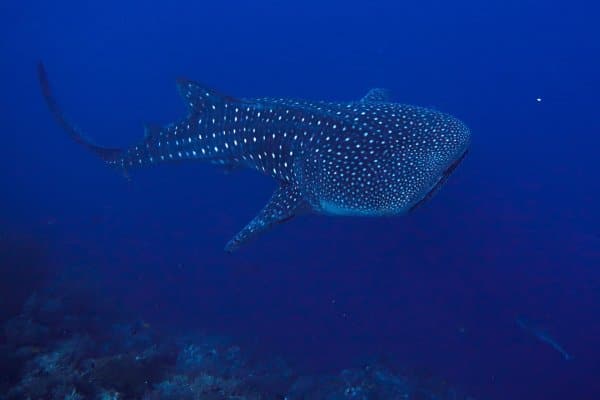
What makes Tubbataha one of the premier scuba diving locations in the Philippines?
If Australia has the Great Barrier Reef, Indonesia has the Komodo Park and Ecuador has the Galapagos Island, then the Philippines has Tubbataha Reefs Natural Park. Recognized as one of the best diving destinations in the world, Tubbataha should be on your dive bucket list.
In 1993, this 97,030-hectare Marine Protected Area was declared a UNESCO World Heritage Site. Here you can find 13 species of dolphins and whales, 13 species of shark, over 600 species of fish, and 360 species of corals.
Tubbataha Reefs Natural Park can be found in the middle of the Sulu Sea, which is located near Palawan. Because of its isolated location, you can only dive in Tubbataha through a liveaboard vessel.
Dive expeditions for Tubbataha normally run for 7 to 10 days at a time and only from March to June. Slots and access to Tubbataha are very limited so sometimes you might need to book 2 years in advance.
It also comes with a hefty price tag so not everyone can live the dream of diving in Tubbataha. However, anyone who has dived stunning and pristine reefs of Tubbataha guarantees that it is worth every dollar.
If you have the privilege and opportunity to visit this premier scuba diving site in the Philippines, then you should immediately snap that chance when you can.
Click here to check prices and availability of Tubbataha liveaboard on Liveaboard.com
The most convenient way to get to Tubbataha: Make your way to Puerto Princesa where most of the Tubbataha liveaboards depart. Some Tubbataha liveaboards may have transition trips where you depart from a port like Cebu or Batangas.
You may also want to read:
Tubbataha Reefs Diving: Ultimate Guide for Scuba Divers
9 Best Tubbataha Liveaboards You Can Take in 2024
7 Biggest Threats to Tubbataha Reefs Natural Park
Tubbataha Reef Activities: 6 Things You Can Do In The Marine Park
2. Apo Reef Natural Park
Located in the Mindoro Strait, Apo Reef Natural Park is the country’s largest contiguous coral reef system, comprising over 34 square kilometers. Many divers claim that this is like a mini Tubbataha as it is a Marine Protected Area where you’ll get the chance to see a wide range of marine life from tiny nudibranchs to gigantic whale sharks.
Sea turtles and sharks can be spotted left and right- a good indicator of a healthy coral reef system. One of my favorite underwater encounters here is a huge school of barracuda.
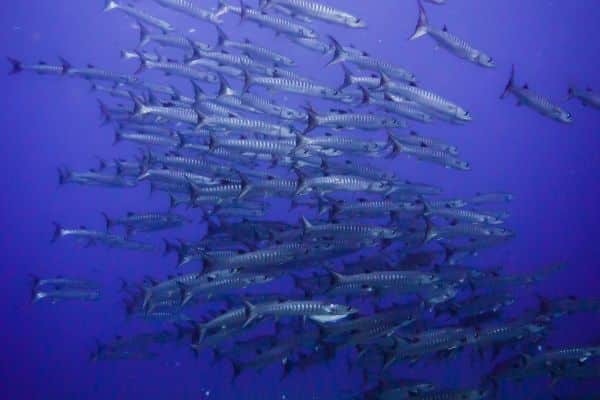
You can visit Apo Reef from the dive shops in Sablayan but I recommend going there on a liveaboard to enjoy the entire park. You’ll get the opportunity to explore several diving sites, see fascinating marine life, and relax in the tranquility of the water. Unlike Tubbataha this marine park is open all year round. To get an idea, you can read my full review on MV Resolute’s Coron-Apo Reef-Puerto Galera Liveaboard trip.
To go to Apo Reef, fly to Manila and then take a domestic aircraft to San Jose Airport in Occidental Mindoro. You can then organize transportation to Sablayan, the entryway of Apo Reef Natural Park. Boat transfers from Sablayan to the reef take about two to three hours.
Read my post on scuba diving in Apo Reef Natural Park to learn more about this dive destination.
3. Malapascua, Cebu
What makes Malapascua one of the best scuba diving locations in the Philippines?
Known for its exceptionally long tail, the threshers shark is one of the coolest sharks you’ll encounter in the Philippines. With a tail almost as long as their body, thresher sharks have a unique ability to catch their prey by stunning it with its tail first.
Thresher sharks are pelagic creatures and it is quite hard to find them. In the rare chance that you see them, they are most likely in very deep or open waters. The thresher sharks in Malapascua are an exemption.
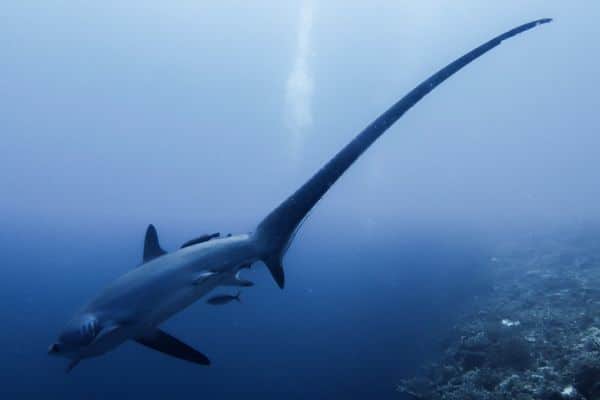
If you go to Monad Shoal and dive down to 30 meters there’s a big chance you’ll see them. The shoal serves as a cleaning station for the thresher sharks, so there’s a high probability that they’ll be there.
The thresher sharks are sighted in Malapascua all year round. If you dream of seeing these beautiful creatures, then this is where you should go. While you’re there you can even take a Thresher Shark Diver Distinctive Specialty course that is exclusively offered in Malapascua Island.
The most convenient way to get to Malapascua Island: From Mactan International Airport make your way to the northern part of Cebu until your reach New Maya Port. The car ride will take approximately 4 hours. Then take a 45-minute pump boat ride to Malapascua Island.
If you would like to learn more about Malapascua Island, read these posts:
Malapascua Diving: Ultimate Guide for Scuba Divers
Gato Island Diving: Exploring a Different Side of Malapascua
4. Coron, Palawan
What makes Coron one of the best diving destinations in the Philippines?
For history-nerds, wreck dive lovers, or technical scuba divers, scuba diving in Coron might just be the dream dive destination for you. Boasting over 20 wrecks from World War 2, Coron is considered to be one of the best wreck diving spots in the world.
Wreck diving in Coron is extremely popular as many of them are short boat-ride away from each other. The wrecks are also well preserved and many of them are within recreational diving limits so even new divers can explore what is left of history.
These Japanese vessels have witnessed countless deaths and the horrors of war, but time and nature have transformed them into beautiful living sculptures. With colorful corals encrusting its metal skeletal remains and marine creatures hiding in every nook and cranny, the wrecks of Coron is truly a unique diving experience.
The most convenient way to get to Coron: From Manila, fly to Busuanga airport in Palawan then take a 40 to 60-minute car ride to Coron town proper.
Read my post Scuba Diving Coron: Wrecks, Reefs and More to learn more about this dive destination.
5. Anilao, Batangas
What makes Anilao one of the best scuba diving destinations in the Philippines?
If you ask any Filipino diver where the best place to go diving near Manila, their top-of-mind recommendation would be Anilao.
Known as the birthplace of scuba diving in the Philippines, Anilao boasts of over 50 dive sites suitable for both beginners to expert divers. With its establishment as a premier dive destination in the Philippines as early as the 1980’s, Anilao has probably produced the most number of certified divers in all of the Philippines.
Many local who have tried diving for the first have fallen in love with scuba because of their experiences while diving in Anilao. If scuba diving is a hobby you want to pursue after all the lockdown, then Anilao is an amazing place to do it.
It is a wonderful place to learn how to dive, not just because of its proximity to Manila but because of the variety of dives you can do in just one place.
Take your pick from vibrant reefs to somber wrecks, sandy bottoms to bottomless abyss, calm waters to strong currents. As you immerse yourself in Anilao’s underwater world, you will surely be amazed with how diverse the sites are.
Anilao has a lot of different kinds of animals and plants, from healthy corals full of colorful reef fish to tiny nudibranchs crawling on the sand. Anilao is one of the best scuba diving spots in the Philippines for honing your skills in both macro and wide-angle photography. If you’re interested in doing a blackwater dive, Anilao is a great place to do it too!
The most convenient way to get to Anilao, Batangas: From Manila, drive all the way to Anilao, Batangas. Travel time is approximately 3-4 hours.
You may also want to read my guide to diving in Anilao for recommendations on where to stay and dive sites to visit.
6. Puerto Galera, Occidental Mindoro
What makes Puerto Galera one of the best scuba diving spots in the Philippines?
Situated on the island of Mindoro, Puerto Galera is famous for its beautiful white sand beach. If you’re looking for some diving and beach bumming that is close to Manila, Puerto Galera would be a good option for you.
In terms of marine life, you will find plenty of both soft and hard corals in Puerto Galera. Colorful reef fishes like anthias, chromis, damsels, butterflyfishes, parrotfishes, wrasses, triggerfishes are fairly common to see. Snappers, groupers, jacks, trevally, baraccudas, and even sharks are something you can also encounter. And of course, lest you forget the friendly neighborhood turtles.
If you’re into underwater macrophotography, nudibrachs, sea slugs, shrimps, crabs and other tiny critters are also found in abundance.
Puerto Galera’s dive sites are also varied with small wrecks, walls, sloping reefs, muck sites, swim-throughs, caves, and more, all only a short boat ride away. You can enjoy all types of diving in Puerto Galera, regardless of your dive certification or experience.
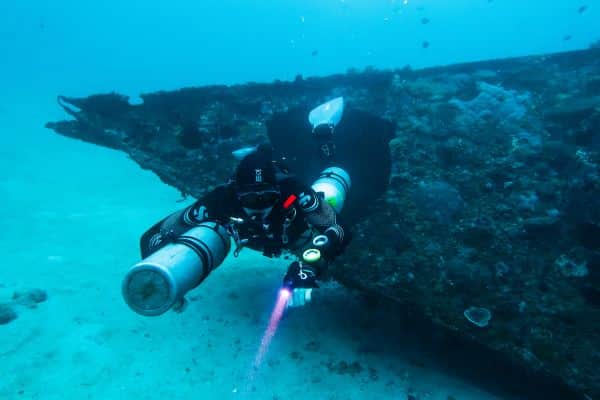
For experienced divers, the deep dives or drift dives in Puerto Galera’s dive site called The Canyons can be a thrilling experience. If technical diving is something you’ve been wanting to pursue, Puerto Galera is a highly recommended place to do it.
Unlike Anilao that is very close to the city and the rest of civilization, Puerto Galera will provide you with a more relaxed island vibe. It’s not completely isolated either as there are several established hotels, dive shops and restaurants in the island that you can enjoy. Because the island is popular not just for divers, there are other activities you can enjoy on Puerto Galera like going on mountain treks or visiting waterfalls.
The most convenient way to get to Puerto Galera: From Manila, take a 2-3 hour car ride to Batangas Pier. From the pier take a ferry to Puerto Galera. Boat ride will take approximately an hour and may vary depending on vessel type.
Read my post on Diving Puerto Galera: Guide for Scuba Divers for more tips and recommendation.
7. Verde Island Passage
What makes Verde Island passage one of the best diving spots in the Philippines?
If you are visiting either Puerto Galera or Anilao, diving in Verde Island Passage is an absolute must! Most divers visit Verde Island from either of these two locations because Verde Island sits in an ocean passage between Batangas and Oriental Mindoro.
Not many people know that the Philippines is actually located in a region in the globe called the “Coral Triangle”. This area is known to have the richest marine life and coral diversity on our planet. Verde Island is said to sit right in the center of that coral triangle, so you can just imagine how abundant and rich that region is.
Dubbed as “the center of the center of marine biodiversity, Verde Island is known for its high concentration of marine species per unit area in the Philippines. So if you were impressed with the amount of marine life in either Puerto Galera or Anilao, you can expect to find more fish, more shrimp, more crabs, more corals, and more of everything in Verde Island.
The most convenient way to get there: Coordinate with your dive resort in either Anilao or Puerto Galera to visit Verde Island Passage. Travel to Verde Island by boat is approximately 1 hour.
Find out in this post why I love-hate diving in Verde Island.
8. Dauin, Negros Oriental
What makes Dauin one of the best scuba diving destinations in the Philippines?
You would think that no one would want to dive in what appears to be a barren wasteland consisting of dark volcanic sand, sediments, and debris. But you’d be surprised with how many underwater photographers head over to Dauin in Negros Oriental just for that!
The coast of Dauin is most known for its unique “mucky” environment where you can find many weird and wonderful creatures like sea slugs, shrimps, cuttlefish, octopus, crabs and more. You can easily tick off several items in your scuba diving critter list when you scuba dive in Dauin.
The marine life in Dauin is astonishing that a dive instructor even created a PADI frogfish specialty course that is exclusively offered in the area. You can also check out this book Nudibranchs of Dauin which features about 300 nudibranch species that have been found in the area.
These are just some proof of how impressive diving in Dauin is when it comes to macro life.
Many divers have claimed that Dauin is similar or even better than the popular muck diving in Lembeh, Indonesia, but I guess you’ll just have to dive Dauin and see for yourself!
The most convenient way to get to Dauin: From Manila take a flight to Dumaguete, Negros Oriental. Then take a 30-40 minute car ride to Dauin.
You may also want to read my guide to muck diving in Dauin for recommendations on where to stay and dive sites to visit.
9. Apo Island, Negros Oriental
What makes Apo Island one of the best scuba diving spots in the Philippines?
Apo Island is a 12-hectare volcanic island that is just a 30-minute boat ride away from Dauin. It is one of the most popular tourist attractions of Negros Oriental due to its close proximity to Dumaguete, the province’s city capital. The island attracts not just scuba divers but also freedivers and snorkelers.
In 1982, a portion of the island was declared a marine sanctuary and these efforts paid off. Today, Apo Island continues to be home to over 615 documented species of fish and about 400 coral species. The Apo Island Marine Sanctuary also became the benchmark and model of success when it came to establishing more sanctuaries in the Philippines.
If you find yourself muck diving in Dauin, make sure to visit the nearby Apo Island for a change of scenery. You will be greeted with a healthy and vibrant coral reef system- the exact opposite of the muck and sandy bottoms you’ll find in Dauin.
Another unique attraction of the island is the number of sea turtles you can find around the island. If you love sea turtles and want to see them up close, Apo Island is one of the best places to swim with sea turtles in the Philippines.
The sea turtle are protected on this island and anyone found harassing and touching them can be fined up to Php5000 (USD100). The sea turtles in Apo Island seem to know that they are protected as they’re very chill and rarely shy away from humans. It won’t be hard to get a selfie with them if you wanted to!
The most convenient way to get to Apo Island: From Manila or Cebu take a flight to Dumaguete, Negros Oriental. Then take a 30-40 minute car ride to Dauin. From Dauin, find a dive resort to take you to Apo Island for diving.
You may also want to read my guide to diving in Apo Island for more dive and travel tips.
Need help planning your trip to Dauin and Apo Island? Sign up below to receive my Dumaguete-Siquijor trip planner spreadsheet.
10. Moalboal, Cebu
What makes Moalboal one of the best scuba diving sites in the Philippines:
Do you want to know what it is like to dive with a million sardines? Head over to Moalboal where you can enjoy this one of a kind, adrenaline-pumping underwater experience.
It is estimated that there are more than 7 million sardines in Moalboal. What is even more astonishing is that this massive school of fish can be found just a few meters from the shores of Panagsama beach all year round.
If you get bored with the Moalboal sardines run, you can always visit the other beautiful dive sites in the area. There’s a small airplane wreck you can visit, or you can get front-row seats to watch the mandarin fish mating ritual.
Just 15 minutes away, you can also dive in Pescador Island where an underwater paradise awaits.
The most convenient way to get to Moalboal, Cebu: From Mactan international Airport in Cebu take a car to Moalboal. Land trip is approximately 3-4 hours.
You may also want to read my guide to the Sardines Run in Moalboal for more travel and dive tips.
11. Panglao Island, Bohol
What makes Panglao one of the best diving spots in the Philippines?
While many tourists flock to Bohol to see the famous Chocolate Hills and the smallest primates called the Tarsiers, scuba divers love visiting Bohol for its underwater wonders. If you enjoy beach-bumming, island-hopping, freediving, or scuba diving, you will absolutely love Panglao.
Located in the southwestern part of Bohol, Panglao Island is one of the famous travel getaways for ocean lovers. It is very easy to get to especially with Bohol International Airport being located on the same island. From Panglao, you can easily visit neighboring islands like Balicasag, Pamilacan, and Cabilao, which also offer amazing dives.
But to be honest, you need not look any further. If you dive along the coast of Alona beach you will surely be a happy diver as you encounter the diverse creatures that call Bohol their home. You will squeal in delight once you find Nemo peeking out of its anemone. And you’ll surely do a little dance underwater when you see not one but three white-eyed eels sharing a hole in a wall.
At night the reef transforms and you’d be amazed by how the reef is equally alive and vibrant as it is during the day. Shrimps, crabs, and sea slugs you normally do not notice will come out and play. So if you’re curious to know what night diving is like, Panglao is a good place to try it for the first time.
One of the things you’ll appreciate in Panglao is having options when it comes to accommodations, restaurants, dive shops, and activities. If you’re a backpacker on a budget or a traveler who loves indulging while on vacation there will be plenty of choices for you.
The most convenient way to get to Panglao Island: From Manila or Cebu take a flight to Bohol–Panglao International Airport. Most dive resorts or accommodations will be within 30 minutes away.
You may also want to read my guide to diving in Panglao Island for recommendations on where to stay and dive sites to visit.
12. Balicasag Island, Bohol
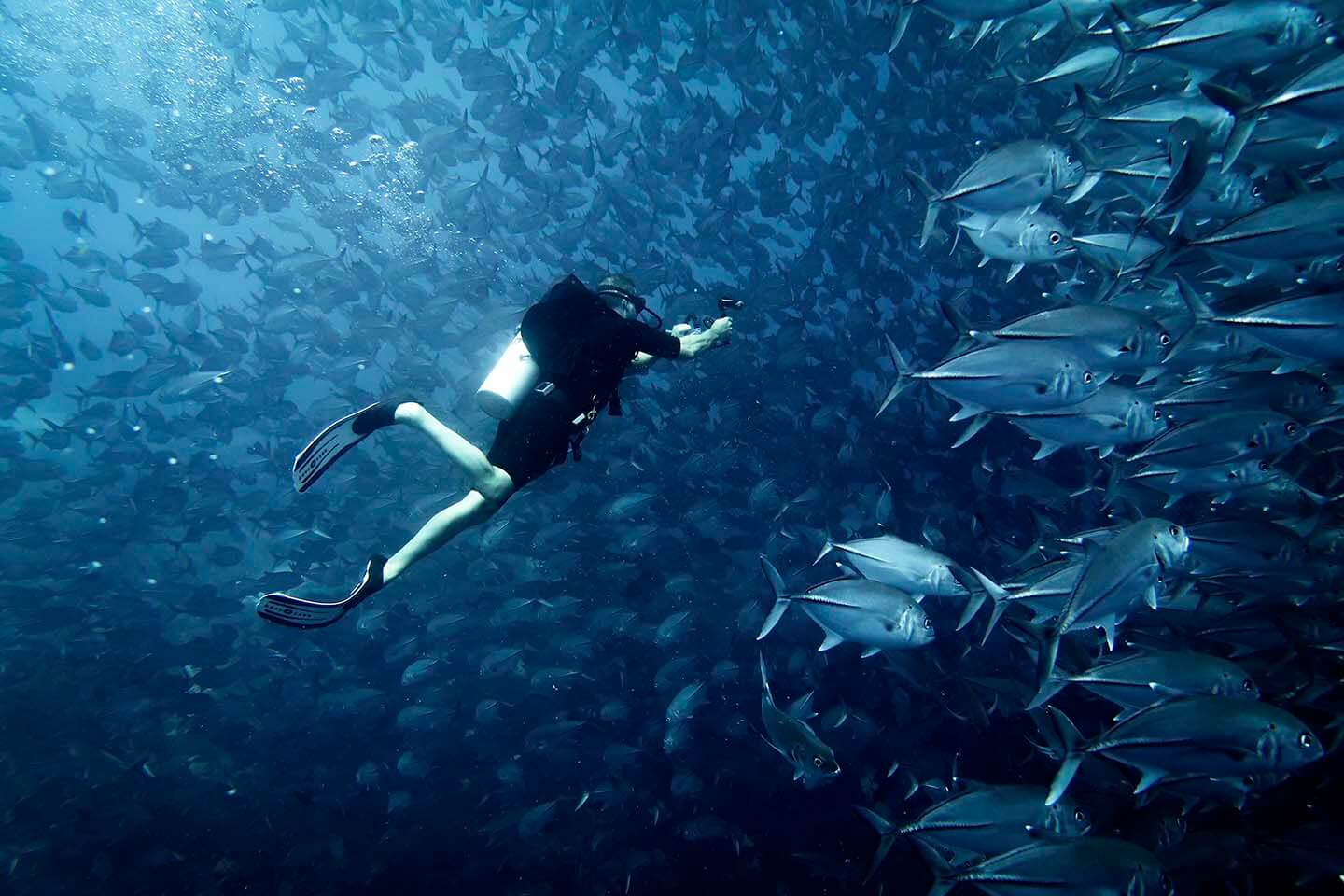
What makes Balicasag Island one of the best diving sites in the Philippines?
If you find yourself in Panglao Island in Bohol, make sure to schedule a trip to Balicasag Island. Just a 30-minute boat ride from Alona Beach, this diving spot is one of the most well-protect marine sanctuaries in Bohol.
Only a limited number of scuba divers and snorkelers are allowed on each island every day to avoid reef damage. This move by the local government has paid off, resulting in a colorful and lush underwater haven.
The sites are aptly named “Diver’s Heaven” where you can encounter not just one but up to 10 sea turtles feeding on seagrass. The massive school of silver jacks is a sight to behold and if you dare, you might just find yourself in the middle of a fish tornado.
Balicasag never fails to impress divers who have made their way to this island. Whether it’s your first or your 100th time to dive here, it will always feel like heaven on earth.
The most convenient way to get to Balicasag Island: If you’re staying in Panglao Island, you can find a dive resort that can take you diving in Balicasag. Book in advance so they can arrange for dive permits.
You may also want to read my guide to diving in Balicasag Island for more travel and dive tips.
Need help planning your trip to Cebu and Bohol? Sign up below to receive my trip planner spreadsheet.
Frequently Asked Questions About Diving in the Philippines
When is the best time to go diving in the Philippines?
Scuba diving in the Philippines can be done all year round however the best time to go is November to May. These are the months when there is less rainfall.
The summer or dry season is from February to May when the water temperature is at its warmest and the underwater visibility is simply amazing.
Amihan and Habagat: Diving Seasons in the Philippines Explained
Best Time To Dive in the Philippines + Monthly Guide on Where to Go
What are the diving conditions like in the Philippines?
Water Temperature
Due to its tropical location, water temperatures in the Philippines is from 24°C-30°C (75°F-86°F).
Most divers wear a 3mm wetsuit while diving in the Philippines. Divers who are used to cooler temperatures can make do without them and dive without wetsuits.
Visibility
You can enjoy really good visibility of more than 30 meters (90 feet) while scuba diving in the Philippines. Of course, this may vary depending on the season, dive sites, and locations.
On average visibility underwater can range from 5 to 20 meters. Most of the best scuba diving sites in the Philippines mentioned on this almost always have really good visibility.
If you’re traveling and diving in the Philippines for the first time, make sure to read my Ultimate Philippine travel and dive guide before heading to your dream vacation!
What dive gear should I pack for diving in the Philippines?
You can easily rent out gear while diving in the best dives sites in the Philippines but bringing your own dive gear is recommended especially if you are doing multiple dives. You should pack your regulator, BCD, masks, fins, protective swimwear, and dive watch.
Here’s a list of scuba gear I use while diving in the Philippines:
My Scuba Diving Gear
Regulator: Scubapro MK25 Evo, C300 and C200 2nd Stage
BCD: Aqualung Axiom
Mask: TUSA M-212 Freedom Ceos
Snorkel: TUSA SP-170 Platina Hyperdry II
Booties: Poseidon Pink Dive Boots
Fins: Problue
Wetsuit: Seavenger
Vest Hoodie: Scubapro Hybrid Hooded Vest
Dive Watch: Suunto D4i Novo
Dive Knife: Aqualung Blunt Tip Knife
Dive Leggings and Rash: Blue Adaptation Coral Sea Fan
My Underwater Camera Gear
Underwater Camera: Canon G7X Mark II
Underwater Camera Housing: Fantasea FG7XII
Video Lights: Big Blue AL1200XP
Underwater Action Camera: GoPro Hero9
360 Camera: Insta360 X3
> Canon G7X Mark II full review
> Insta360 X3 underwater camera review
> Scuba diving camera recommendations for beginners.
Dive Insurance
Divers Alert Network (DAN)


Need travel insurance for your trip? Get a quote from Safety Wing.
Aside from your standard dive kit, here are some packing tips for your trip to the Philippines:
If you don’t intend to wear a wetsuit, at least wear protective gear like rash guards and scuba leggings. You might encounter a dangerous marine animal that could harm you and ruin your dive trip. Read this post on 15 dangerous sea creatures in the Philippines to find out what animals you need to watch out for.
Many sites have shore entries so I recommend packing your booties with your fins.
Snorkels are optional but I like to bring mine because many of these places are fantastic not just for diving but for snorkeling as well.
Dive knives or fishing wire cutters are optional. They do come in handy as you might encounter some ghost nets and trash that may have trapped some marine animals.
I highly recommend doing a night dive in the Philippines so pack your underwater dive light if you have one. Here are some recommendations for the best dive lights.
Most shops use a yoke valve for their tanks so double-check with your dive shop if they have tanks with a DIN valve or have an adaptor.
Make sure to get scuba diving insurance so you’re covered while traveling and diving in the Philippines. Remember that we are a third-world country and hospital and emergency facilities may be scarce or hard to get to. Getting diver’s insurance can give you that extra peace of mind in case of an emergency. I personally use Divers Alert Network (DAN). But you can also check Dive Assure.
For more packing tips, read my post on Philippine Packing List: What to Bring to Your Dive Trip or sign up below to get a copy of my packing checklist.
Do you have Pinterest? Pin this for later!
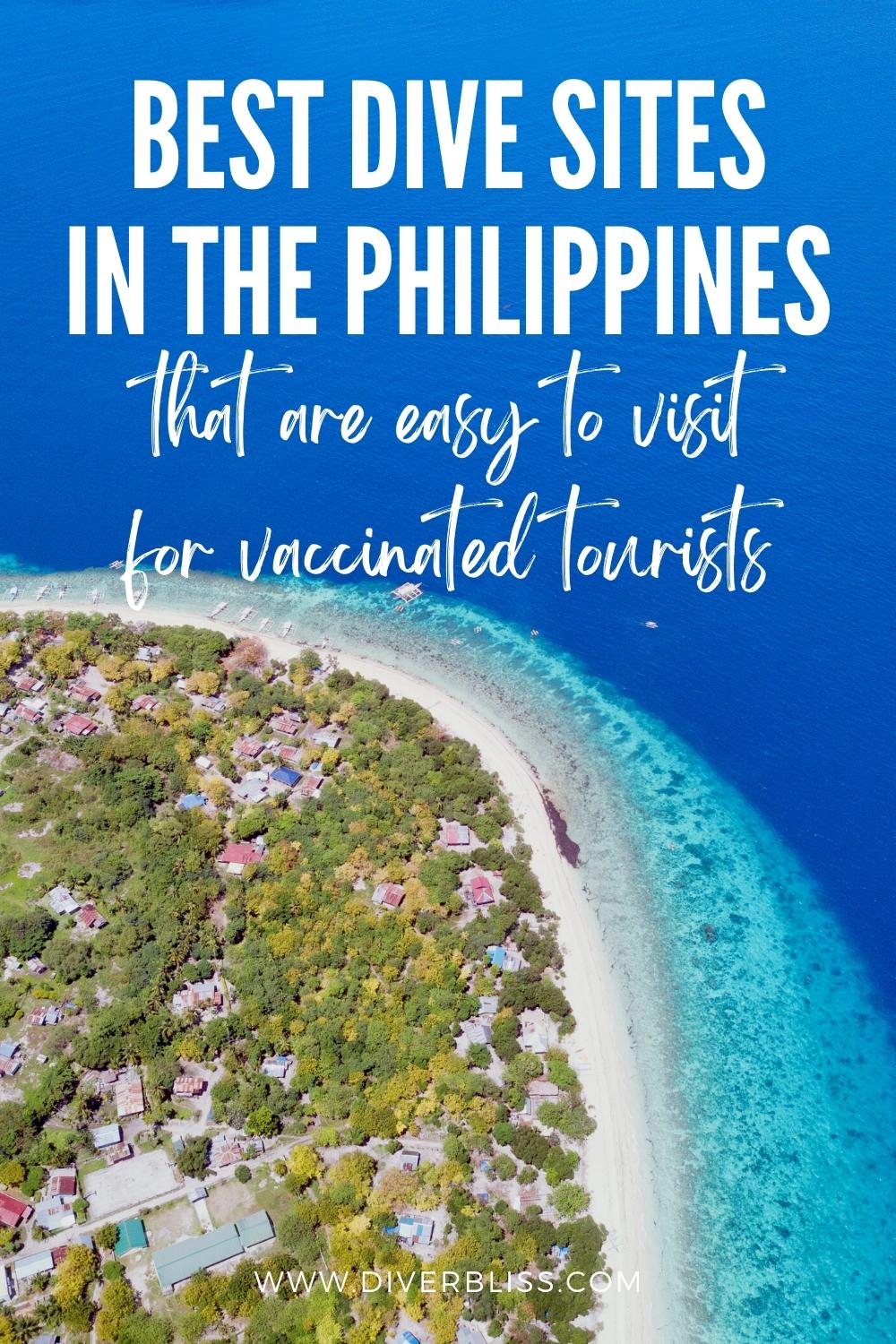
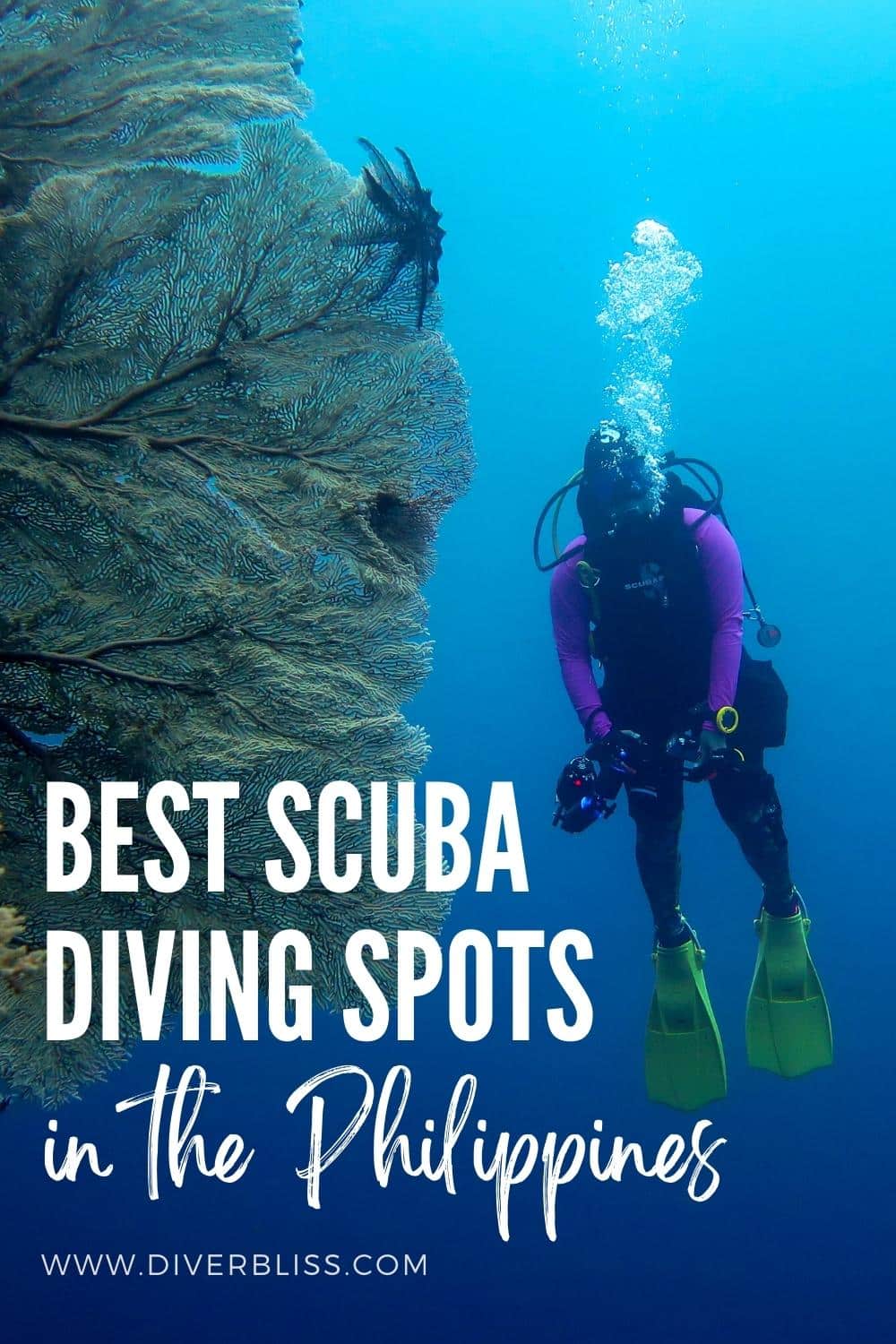
Do you have a favorite scuba diving site in the Philippines? For you, what is the best scuba diving spot in the Philippines? Which scuba diving locations in the Philippines do you want to visit in 2023? Leave a comment below!
